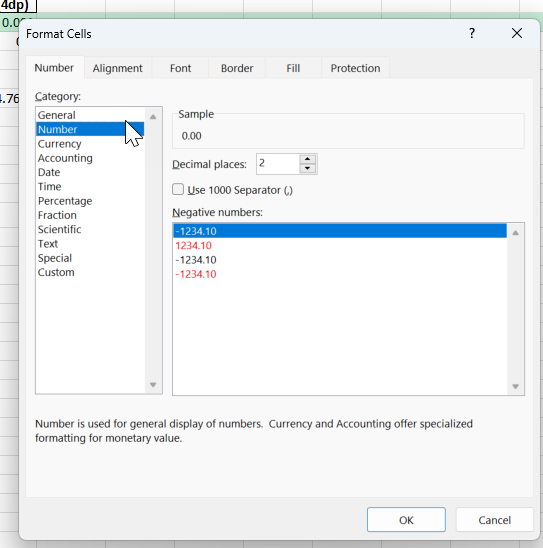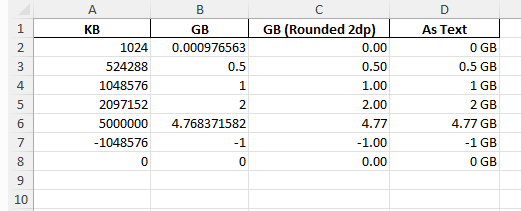Key Takeaways
- There are 1,048,576 KB in 1 GB when using binary (base-2) conversion, which is standard for computer storage.
- You can convert KB to GB in Excel with a simple division formula: =A2/1048576.
- Excel’s
CONVERTfunction does not directly support KB to GB, so manual formulas are needed. - Formatting your result to show the correct number of decimal places keeps your reports clear.
- Power Query and VBA can automate bulk conversions or apply custom formatting for large datasets.
Table of Contents
About File Size Units: KB, MB, GB
File size is often measured in kilobytes (KB), megabytes (MB), and gigabytes (GB). Here are the common relationships used in computer storage:
- 1 KB = 1,024 bytes
- 1 MB = 1,024 KB
- 1 GB = 1,024 MB = 1,048,576 KB
Note: Some systems use decimal (1 GB = 1,000,000 KB) for marketing or hardware, but Excel calculations usually follow the binary (base-2) standard.
Understanding Data Measurement Units
Basics of Kilobytes and Gigabytes
In the digital world, data measurement units are crucial for understanding file sizes and storage needs. Kilobytes (KB) and Gigabytes (GB) represent points on the data scale. A kilobyte is a unit of digital information equal to 1,024 bytes. This measure was essential back when files were generally smaller. Today, you’re more likely to encounter Gigabytes—each equivalent to 1,024 megabytes or approximately 1,073,741,824 bytes. This substantial capacity can house everything from complex software applications to high-resolution videos.
Understanding these basic units helps you manage storage effectively. For instance, knowing that a document is 50 KB helps determine whether it fits in an email, while a GB-sized file might need cloud storage solutions.
How Data Size Impacts Storage and Usage
Data size directly influences storage capacity and device performance. When managing files and applications, comprehending how data size affects storage is vital. Larger files, measured in Gigabytes, can quickly fill up available space, leading to sluggish performance and requiring regular data cleansing or hardware upgrades. An image-heavy presentation in GB size may necessitate cloud storage, freeing up local resources and ensuring smoother operation.
Your usage also hinges on data size. Larger files may demand stronger internet bandwidth for download or upload, affecting how quickly content is exchanged. Furthermore, software programs ballooned by unnecessary data consume more system memory, impacting multitasking ability and reducing overall efficiency. Understanding these factors allows for prudent data management, maximizing storage and maintaining optimal device functionality.
How to Convert KB to GB in Excel
Step 1: Enter Your Kilobyte Values
Type your KB value in cell A2 (for example, 2097152 for 2 GB).
Continue your KB values in column A for as many rows as needed.
Step 2: Convert KB to GB with a Formula
In cell B2, enter:
=A2/1048576
This divides the KB value by 1,048,576 (the number of KB in a GB).
Copy the formula down for the rest of your data.
Step 3: Format the GB Result
Select your GB column (e.g., column B).
Right-click and choose Format Cells > Number.
Set the decimal places (2 to 4 is usually best for GB values).
Step 4: Add a Label or Unit to Your GB Result
In cell D2, enter:
=ROUND(B2,2) & " GB"
This creates a text version like “2 GB” or “0.5 GB” for easier reporting.
Common Mistakes and Tips
Mistake: Using 1,000,000 instead of 1,048,576
Always use the correct binary conversion (1,048,576) unless you know your data source uses the decimal version.
Mistake: Forgetting to format decimal places
GB results may look messy without proper formatting. Set your GB column to the appropriate number of decimals.
Tip: Use absolute references for the divisor
Place 1048576 in a separate cell (e.g., E1) and use =A2/$E$1 for flexibility.
Tip: Document your unit conversions
Add a header or note explaining the conversion factor in your worksheet for future reference.
Tip: Use helper columns for easier calculations
Separate raw data, converted values, and text labels in your sheet.
Bonus Tips and Advanced Scenarios
VBA Macro to Convert KB to GB in Bulk
Use this macro to convert a selected range of KB values to GB:
Sub ConvertKBtoGB()
Dim cell As Range
For Each cell In Selection
If IsNumeric(cell.Value) Then
cell.Offset(0, 1).Value = cell.Value / 1048576
End If
Next cell
End Sub
This places the GB value in the next column.
Power Query: Automated Unit Conversion
In Power Query, add a custom column: =[KB]/1048576
Handling Mixed Units
Use a helper column to convert MB to GB first (=MB/1024), then KB to GB.
Practical Use Cases
Tracking disk usage or cloud storage costs
Analyzing data exports from large databases
Reporting backup sizes over time
Comparing file sizes for IT planning or procurement
Presenting results in dashboards or summary reports
FAQ
Q: What is the formula to convert KB to GB in Excel?
A: Use =A2/1048576 where A2 has your KB value.
Q: Does Excel have a built-in function for KB to GB?
A: No, Excel’s CONVERT function does not support KB or GB directly for file sizes. Use division as shown.
Q: How can I show results with only 2 decimal places?
A: Use =ROUND(A2/1048576,2) or set decimal formatting via Format Cells.
Q: What if my KB value is negative?
A: The formula still works. A negative KB will return a negative GB.
Q: Can I convert the other way (GB to KB)?
A: Yes, multiply by 1,048,576: =A2*1048576.
John Michaloudis is a former accountant and finance analyst at General Electric, a Microsoft MVP since 2020, an Amazon #1 bestselling author of 4 Microsoft Excel books and teacher of Microsoft Excel & Office over at his flagship MyExcelOnline Academy Online Course.













